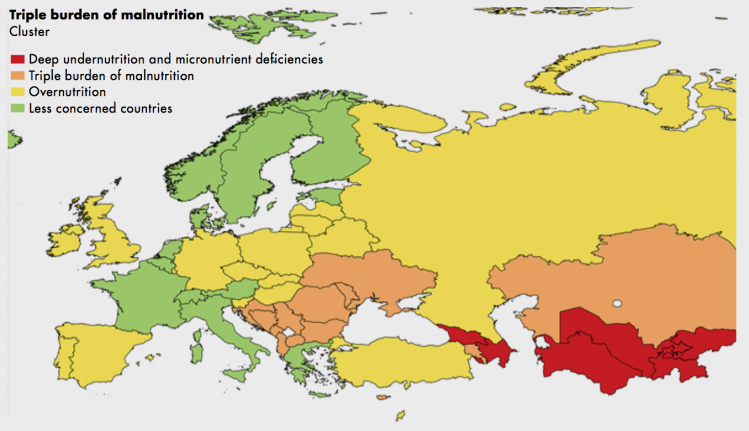Europe and Central Asia in ‘nutrition transition’: FAO report

The report – Regional Overview of Food Insecurity: Europe and Central Asia[PDF] – analyses 23 years of nutrition, health and economic data to illustrate how nutrition issues across the region have changed.
Undernutrition is now an issue for only a few countries, with just 7% of the population of Europe and Central Asia (ECA) affected. But 13% of the ECA population faces the so-called ‘triple burden’ of undernutrition, micronutrient deficiencies and overnutrition combined.
57% get too much food
By far the biggest issue for the region is overnutrition, which affects 57% of the population, including Western European countries such as Germany, the UK, Ireland, Spain and Portugal. These countries face higher rates of obesity and the resulting increases in non-communicable diseases such as diabetes, cancer and heart disease.
“As countries in the region have become more affluent, the availability of macronutrients (proteins, carbohydrates and fats) and their associated calories, even in the poorest countries, has risen well above minimal daily needs. As part of this process, consumption patterns have also changed, giving rise to new threats to food security,” wrote the report’s author David Sedik.
In contrast, 23% of the ECA population has undergone yet another transition, to more balanced diets, and thus with lower levels of overweight and obesity. These mostly include higher-income countries such as the Nordic countries, France, Switzerland and Austria, but also Greece.
Healthcare costs rise through transitions
As countries go through these transitions, healthcare expenditure will need to rise to deal with issues such as diabetes and heart disease, the report states.
It gives figures showing a one-year increase in life-expectancy was associated with a 99% increase in healthcare spending for undernutrition countries – but a 144% increase for triple-burden countries, using data from 1995 to 2010.
In contrast overnutrition countries spent 37% more, and countries with lower nutritional concerns spent just 24% more.
The report finds economic development is the key – but not the only – factor in reducing malnutrition.
“The experience of the past 23 years suggests that ensuring sustained long-term growth of the economy is central to further poverty reduction in the region, and is thus assumed to be key to ensuring food security,” wrote Sedik in the report.
Micronutrient mystery
But issues such as micronutrient deficiency are only moderately linked to income levels, the FAO finds. It highlight research suggesting maternal education may also be a factor – and in Central Asian countries, iron fortification efforts had a significant impact on anaemia and stunting levels.
“However, with the exception of the flour and salt fortification measures implemented in Central Asia in the 2000s, it is not possible to identify which factors explain the differences in these indicators in individual countries,” wrote Sedik.
Trends around weight are much clearer, though: “[T]he overweight and obesity data are closely tied to per capita incomes. Those segments of the population that are overweight and obese display clear upside- down U-curves … as per capita incomes increase.
“In other words, this population segment tends to increase as per capita incomes grow until a level of between US$30,000-40,000 (in 2010 international dollars), after which the trend is reversed,” Sedik added.
The report also provides policy recommendations for improving nutrition in the ECA region. These include food fortification and reformulation, nutrition education and food safety, but also the implementation of fiscal measures to incentivise better dietary choices.








